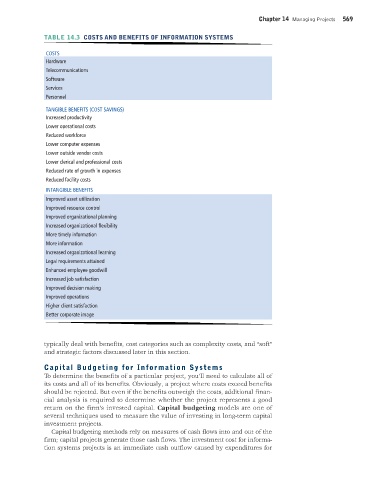Page 570 -
P. 570
Chapter 14 Managing Projects 569
TABLE 14.3 COSTS AND BENEFITS OF INFORMATION SYSTEMS
COSTS
Hardware
Telecommunications
Software
Services
Personnel
TANGIBLE BENEFITS (COST SAVINGS)
Increased productivity
Lower operational costs
Reduced workforce
Lower computer expenses
Lower outside vendor costs
Lower clerical and professional costs
Reduced rate of growth in expenses
Reduced facility costs
INTANGIBLE BENEFITS
Improved asset utilization
Improved resource control
Improved organizational planning
Increased organizational flexibility
More timely information
More information
Increased organizational learning
Legal requirements attained
Enhanced employee goodwill
Increased job satisfaction
Improved decision making
Improved operations
Higher client satisfaction
Better corporate image
typically deal with benefits, cost categories such as complexity costs, and “soft”
and strategic factors discussed later in this section.
Capital Budgeting for Information Systems
To determine the benefits of a particular project, you’ll need to calculate all of
its costs and all of its benefits. Obviously, a project where costs exceed benefits
should be rejected. But even if the benefits outweigh the costs, additional finan-
cial analysis is required to determine whether the project represents a good
return on the firm’s invested capital. Capital budgeting models are one of
several techniques used to measure the value of investing in long-term capital
investment projects.
Capital budgeting methods rely on measures of cash flows into and out of the
firm; capital projects generate those cash flows. The investment cost for informa-
tion systems projects is an immediate cash outflow caused by expenditures for
MIS_13_Ch_14_global.indd 569 1/17/2013 2:31:59 PM

